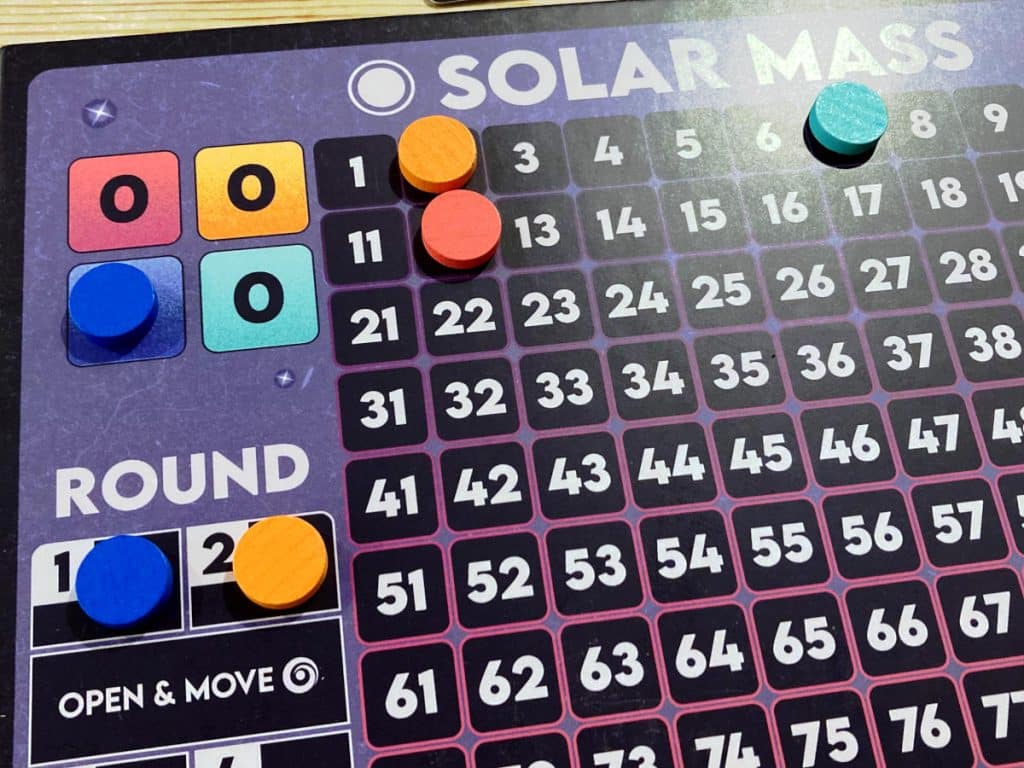| Release Date: 2025 | Players: 2-4 |
| Designer: Alex Greenberg | Length: 60-120 minutes |
| Artist: Alex Greenberg, Dayanara Agila | Age: 12+ |
| Publisher: Studio Unknown | Complexity: 2.5 / 5 |
| Plastic (by weight): n/a | Air (by volume): n/a |
A black hole is a region of spacetime where gravity is so strong that nothing, not even light, can escape. Black holes are enormous and entirely ungovernable. They form when massive stars collapse on themselves at the end of their life. They grow by absorbing mass from their surroundings and if they absorb other stars or merge with other black holes, they become supermassive, millions of solar masses in size. Yet, some black holes are even more gigantic and powerful. They are Ultramassive by Alex Greenberg and Jacob Phillips from Studio Unknown.
Listen to the Audio Version
Intro Music: Bomber (Sting) by Riot (https://www.
Music: bensound.com
License code: 0J0DK5719NKUBIV9
Music by Bensound.com/royalty-free-music
License code: YNZBKH8IPGZTSQV4
Ultramassive Gameplay
Yes, here is a game that has a scientific theme, but rather than putting players into the role of astronomers who map stars or research the depths of the visible universe, in Ultramassive you are a black hole. Yes, you heard it right. You’re a former star that has collapsed into itself. You have become so dense that you warp space and time itself and your mission is to outgrow your competitors to become the biggest and heaviest object in space. If you can end the game with a greater solar mass than everyone else, you win.
The challenge isn’t simple either, as you all play against a clock that is relentlessly ticking down millennia in the blink of an eye. You have to outdo everyone else before the heat death of the universe, which in this game is six rounds where you will absorb matter and anti-matter, create anomalies that allow you to become more efficient at hoovering everything up and ever so often bloat to the next size up.
As you can tell, everything in Ultramassive works on a gigantic scale. The title itself sets the scene. So while you start out as a mere micro black hole, you’re already the size of the Moon. The game’s small number of rounds each represents millions of years. Your goal isn’t simply to become supermassive, but ultramassive. You want to grow a hundred times, from one solar mass to one hundred, in six turns.
The mind boggles. It’s impossible to truly understand the numbers involved. Yet, the game itself isn’t actually too hard to grasp, even though I think the rulebook could do with some tweaking to make it easier to use as a reference later on. However, if you watch some of the playthrough videos, you should be fine.

Worker Placement and Tech Trees
Each round works the same way. In player order, everyone chooses one of a set of available actions. Then, in reverse order, everyone chooses an option from a second set of actions. So each round you will have two actions. It’s a sort of worker placement mechanism mixed with bidding, because actions are carried out left to right. A more powerful action comes after other actions. Conversely, the weakest action happens first.
That in itself creates an interesting tension, but there is another twist.
There are both matter and anti-matter in Ultramassive. Like in real life, these cancel each other out. You don’t want them to touch each other. Yet, there is an action you can choose, that comes last, where you can force everyone to place anti-matter. So if someone goes early and chooses to add a lovely chunk of matter that they will slowly absorb to get them to grow another size, you can be mean and force them to blow it up with a piece of anti-matter.
It’s all about timing and in fact, timing is key in Ultramassive. When you add what type of matter is important. You need to think about whether you want everything to rotate one step to get closer to your black hole, so that you can eventually absorb more mass and grow, or whether you try and collect more mass first. You also have the option to create anomalies, which form a tech tree and make your black hole more efficient and effective.
It is impossible to do everything you want, so you have to choose. Sometimes you don’t even get a choice at all when the action space you so desperately wanted is taken by someone else. You have to constantly adapt and take tactical decisions.

Big Bang or Small Fizz
So there is a lot happening in Ultramassive. You have many decisions to make. It’s not a light game by any means.
Yet, I am missing the gigantic scale the game seems to want to offer players. When I first saw the rules, I was expecting a Big Bang, but when I played it, I only felt a small fizz. Don’t get me wrong, the game is very enjoyable, but I never felt like I was doing anything amazing or epic.
It is wonderful when you get the right combination of anomalies and start to absorb more matter more quickly. You can see your black hole grow at a breathtaking pace, overtaking everyone else in a matter of a few rounds. It feels lovely placing a larger black hole onto your player board to show how far you’ve come. Being able to blow up another player’s matter with anti-matter is great. The artwork has a lovely 1970s science-fiction feel about it and really works. It looks cool on the table.
Overall though, it doesn’t feel ultramassive. I was hoping to see more player interaction. It would have been great if the game had allowed you to steal matter from another player via wormholes. If the anomaly cards were limited so that not everyone could get one, it would create extra tension. Players would have to race to be the first to claim what they wanted, leaving others behind.
I know. What I say sounds quite harsh. Ultramassive is a really enjoyable game that will keep you busy for an hour or two. Just don’t expect giant explosions or dramatic outcomes. I suppose that is quite fitting, because everyone is a black hole and to a black hole, everything else must appear tiny and ordinary.
For behind-the-scenes updates, branded merchandise, and more, please support the blog.
Useful Links
- Ultramassive: https://www.
studiounknowngames. com/ ultramassiveboardgame - Rulebook: https://www.
studiounknowngames. com/ _ files/ ugd/ 3543fc_ e4111f93dcbd4034a12b939d314a9e9c. pdf - Kickstarter page: https://www.
kickstarter. com/ projects/ studio-unknown/ ultramassive - Studio Unknown: https://www.
studiounknowngames. com/ - BGG listing: https://boardgamegeek.
com/ boardgame/ 407965/ ultramassive
Videos
Transparency Facts
I feel that this review reflects my own, independent and honest opinion, but the facts below allow you to decide whether you think that I was influenced in any way. Please also read my Ethics Statement for more information.- I was given a free review copy of this game by the publisher.
- At the time of writing, I have not received financial support from the publisher or anyone working on their behalf.
Audio Version
Intro Music: Bomber (Sting) by Riot (https://www.
Music: bensound.com
License code: 0J0DK5719NKUBIV9
Music by Bensound.com/royalty-free-music
License code: YNZBKH8IPGZTSQV4
Playlist
These are the songs I listened to while I was writing this review:






